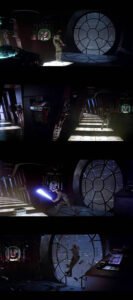Have you ever put any thought into the lightsabers in a New Hope, the original Star Wars film? I mean, these futuristic laser swords used by hippie knights looked so realistic, and decades ahead of their time, I thought they were real things when I was a kid. I wasn’t really aware of special effects at that age, but then again, very few people really were. Decent computer generated graphics were still more than ten years off. So how did they make the lightsabers in a New Hope look so realistic? The answer is almost as surprising as how quickly it was completed.
Without a doubt one of the most iconic science fiction movies ever produced would be Star Wars – A New Hope (originally released only as Star Wars). It pushed the boundaries of special effects and amazed audiences around the world. One of the greatest, and mind blowing features of the movie were the lightsabers. They were glowing laser swords used by the Jedi knights and the Sith lords, such as Darth Vader. So, how could George Lucas and his team make the lightsabers look so realistic in a time before computers? They had to be drawn by hand. How long did it take? You will be surprised to learn it took one man only one week to complete the entire lightsaber scenes in the movie.
Korean animator Nelson Shin was working for an American company at the time when his manager asked him to animate the lightsaber live action scenes in the movie. He used a rotoscope to complete the work. Rotorscoping is where the film is projected onto a frosted panel, frame by frame, and it is redrawn by the animator. Clearly it would have been painstaking, time consuming work. What made Shin’s effort so amazing was that it was completed in only one week.
But his work with the lightsaber in Star Wars didn’t end there. Along with his art work being featured as the lightsabers, he also suggested the sound and shimmering effect of them. He explained to Lucasfilm representatives that as the lightsaber was made out of light, it should look a little shaky like a fluorescent tube. He also suggested the sound of the sword should be reminiscent of a magnetic field.








